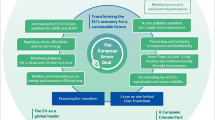Abstract
The Orchestra of Treaties scenario emerges if countries share the following principles for re-building the climate regime (1) recognize the sovereignty concerns attending energy policies; (2) build upon national interests in technology and development; (3) avoid conflicts and enhance cooperation by appropriately framing core issues; and (4) address not only short-term emission cuts but also long-term technological change.In this scenario, countries will share these principles by drawing on the hard lessons of past UNFCCC negotiations. The framing of the climate change problem as the allocation of emission quota created an adversarial style of negotiation that resulted in distrust among countries. Moreover, the negotiations have been characterized by unpredictable outcomes. Since energy policies were deemed as sovereignty concerns, countries did not want to put such issues on the agenda to avoid a potentially intrusive outcome. This negotiation style brought about shortcomings of the Kyoto Protocol and may lead to a stalemate in future negotiations.
The scenario captures the dynamics that emerge when multiple efforts are pursued by flexible coordination of actors motivated through diverse incentives. The emerging regime, the Orchestra of Treaties, will consist of four building blocks, of which three grow outside of UNFCCC.
-
(1)
Group of Emission Markets (GEM) begins with separate domestic markets without internationally imposed emission targets. The markets are then gradually coordinated through price signals. The advantage of this pathway is that it fosters the establishment of emission markets without conflicting with sovereignty concerns for energy policy, thereby enabling key large emitters to establish emission markets.
-
(2)
Zero Emission Technology Treaty (ZETT) that addresses long-term technological change. This will set zero CO2 emission from the energy sector as the long-term goal, thereby creating strong signals to stakeholders. It will begin as a non-binding pledge and review system so that it does not conflict with sovereignty concerns.
-
(3)
Climate-wise Development Treaty (CDT) that addresses the concerns of developing countries, which are development, adaptation, technological transfer and mitigation. In this treaty, developed countries agree to revise their assistance policies to make development more sustainable and climate-wise.
-
(4)
UNFCCC will serve as an information exchange arena, target funding mechanism and a political focal point.
-
If the political interests and views remain diverse across countries, the Orchestra of Treaties may be the most environmentally effective regime among the alternatives. As for the evolution over time, once the technological and political feasibility of some climate policies have been demonstrated by key developed countries, all countries will be confident enough to deepen their commitments in the wider issue area. They might eventually return to a Kyoto-type structure with full participation once confidence has been built, but this may take decades.
-
Concerns frequently voiced about this scenario include that the regime may impose additional negotiating burden upon developing countries, or that a departure from a Kyoto style framework may end up with losing political momentum.
-
Similar content being viewed by others
Abbreviations
- UNFCCC:
-
United Nations Framework Conventions on Climate Change
- GEM:
-
Group of Emission Markets
- ZETT:
-
Zero Emission Technology Treaty
- CDT:
-
Climate-wise Development Treaty
- SO x :
-
sulfur dioxides
- CO2:
-
carbon dioxide
- R&D:
-
research and development
- GHG:
-
greenhouse gases
- KP:
-
Kyoto Protocol
- GEF:
-
Global Environmental Facility
- COP:
-
Conference of Parties
- IEA:
-
International Energy Agency
- CERN:
-
European Organization for Nuclear Research
- ODA:
-
Official Development Assistance
- NO x :
-
Nitrous oxides
References
K.A. Baumert (Eds) (2002) Building on the Kyoto Protocol: Options for Protecting the Climate World Resources Institute Washington, DC
den Elzen M. (2003), ‘Modelling Different Policy Scenarios: Impacts on Global Emissions’, presentation at Post-2012 Climate Policy Options: European Perspectives, conference at Hamburg Institute of International Economics, 4–5 September 2003
Y. Fujii K. Yamaji (1998) ArticleTitleAssessment of Technological Options in the Global Energy System for Limiting the Atmospheric CO2 Concentration Environmental Economics and Policy Studies 1 IssueID2 113–139
P.M. Haas R.O. Keohane M.A. Levy (Eds) (1993) Institutions for the Earth: Source of Effective International Environmental Protection MIT Press Cambridge, MA
T. Heller P.R. Shukla (2003) Development and Climate: Engaging Developing Countries, Working Draft Pew Center on Global Climate Change Washington, DC
IEA (2002), Beyond Kyoto: Energy Dynamics and Climate Stabilization. Paris: IEA Publications, available online at http://www.iea.org/dbtw-wpd/Textbase/envissu/cop9/files/beyond_kyoto.pdf (Accessed 27 August 2004)
McDonald, A. and L. Schrattenholzer (2001), ‘Learning Rates for Energy Technologies’, Energy Policy 29(4), 255–261, Reprinted as RR-01-014, International Institute for Applied Systems Analysis, Laxenburg, Austria
J. Pershing F. Tudela (2003) A Long-term Target: Framing the Climate Effort, Working Draft Pew Center on Global Climate Change Washington, DC
C. Philibert (2004) International Energy Technology Collaboration and Climate Change International Energy Agency Paris
L. Salter (1988) Mandated Science: Science and Scientists in the Making of Standards Kluwer Academic Publishers Dordrecht
T. Sugiyama (2003) The Scenario Analysis of Global Policy to Prevent Global Warming Central Research Institute of Electric Power Tokyo Industry
UNEP/RIVM/IIED (2003), ‘Development and Climate Project’ homepage, available online at www.developmentfirst.org (Accessed 30 August 2004)
Victor, D (2003), ‘After Kyoto’, presentation at Symposium on the Future Framework on Climate Change Beyond 2012, New Energy and Industrial Development Organization (NEDO) and Global Industrial and Social Progress Research Institute (GISPRI), Tokyo, 19 September 2003
D. Vogel (1995) Trading Up: Consumer and Environmental Regulation in a Global Economy Harvard University Press Cambridge, MA
O. Young (2002) The Institutional Dimensions of Environmental Change: Fit, Interplay, and Scale MIT Press Cambridge, MA
Author information
Authors and Affiliations
Corresponding author
Rights and permissions
About this article
Cite this article
Sugiyama, T., Sinton, J. Orchestra of Treaties: A Future Climate Regime Scenario with Multiple Treaties among Like-minded Countries. Int Environ Agreements 5, 65–88 (2005). https://doi.org/10.1007/s10784-004-3702-6
Issue Date:
DOI: https://doi.org/10.1007/s10784-004-3702-6




